If you live in a cooler region and normally miss out on the many flowering plants that need warmer conditions, well, we might just have the perfect pick for you.
Lily of the valley is a spectacular woodland flowering plant with sweetly scented dainty bell-shaped flowers that sit on gently arching stems and vibrant green ovate leaves.
It is widely grown in gardens for its decorative white or pale-pink flowers and its ground-covering abilities. Here is your comprehensive guide to growing and caring for the lily of the valley.
More...
Family: | Asparagaceae |
|---|---|
Genus: | Convallaria |
Species: | C. majalis |
Common Names: | Lily of the Valley, May bells, Our Lady’s tears, Mary’s tears |
Location: | Outdoor |
Type: | Flowering plant |
Growth: | 45cm tall and 30cm wide |
Sun requirements: | Partial shade to full shade |
Foliage Colour: | Green |
Flower Colour: | White |
Flowering: | Spring |
Fruits: | Red berry seedpods after flowering |
Maintenance level: | Low |
Poisonous for pets: | Very toxic to cats, dogs and humans if ingested |
Getting to Know the Lily of the Valley
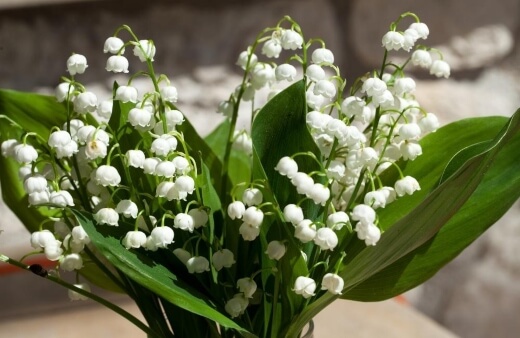
This herbaceous perennial plant is perfect for shady gardens, being able to easily spread using its underground stems called rhizomes. The delicate flower heads are borne in sprays on the bowing stems with up to 15 flowers per stem.
Highly ornamental, this plant also prefers to be left alone once established so it’s a good option for any grower regardless of experience. The scented flowers are notoriously used in many floral bouquets and also make for fantastic additions to floral arrangements around the house.
Lily of the Valley Botanical Name
Part of the family Asparagaceae, these plants are native throughout cool temperate regions in the Northern Hemisphere, Asia and Europe. Botanically named Convallaria majalis, this plant is now commonly known as Lily of the Valley, May bells, Our Lady’s tears or Mary’s tears.
They thrive and flower best in cool climates within shaded gardens in cold and damp conditions. They take some know-how to establish, usually only reaching full maturity after a few years when left undisturbed.

May Bells Growing Habits
In cultivation, it will grow to roughly 45cm tall and 30cm wide depending on the conditions and it is generally considered a slow-growing species.
Mainly planted as an ornamental filling for beds, this plant can also be used as a groundcover in woodland settings and is perfect planted beneath the canopies of large trees.
For those interested in container growing, you’ll be happy to know that lily of the valley can easily thrive in containers around shady areas in the garden. One caveat to this plant is that it is highly poisonous if ingested by humans, pets and many other animals.
Therefore, placement in your landscape will need to be well thought through and when dealing with the plant, it is best to use gloves and other protective gear to be as safe as possible.
Look into getting the right gardening gloves in our review of the best gardening attire for 2024.
Popular Lily of the Valley Varieties & Cultivars
Asian Lily of the Valley (Convallaria keiskei)
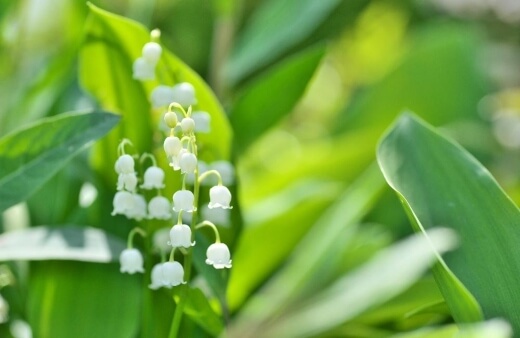
Known as the Asian Lily of the Valley, this variety is native to China and Japan and it features red fruits, bowl-shaped tiny white flowers and brilliantly smooth, large growing foliage.
It usually grows up to 30 centimetres tall so it is also known as a larger growing variety.


Get Your Free Guide:
Master Growing Australian Natives eBook
A Must Have Complete Guide for Every Australian Garden
Get Your Free Guide:
Master Growing Australian Natives eBook
A Must Have Complete Guide for Every Australian Garden
American Lily of the Valley (Convallaria montana)
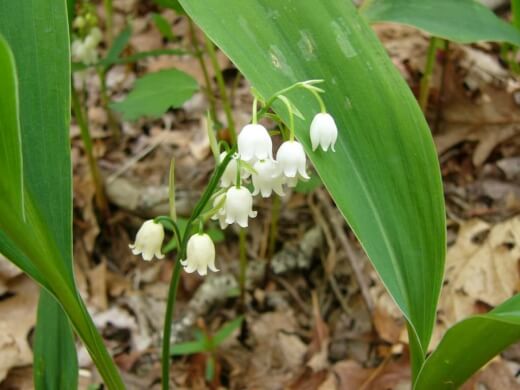
Source: worldoffloweringplants.com
Native to the United States, this plant is naturally known as the American Lily of the Valley. This variety can produce greenish veins and variegation in its leaves and flowers.
It grows up to 25 centimetres tall and features larger arching flower stems.
Striped Lily of the Valley (Convallaria majalis ‘Albostriata’)

Source: farreachesfarm.com
This cultivar is noted for its luscious creamy white variegated foliage that features white-stripped leaves. Cultivated plants will grow to around 15 to 20 centimetres tall and 20 to 60 centimetres wide.
This specific variety won’t lose its variegation with age like many of the others do.
Convallaria majalis ‘Green Tapestry’
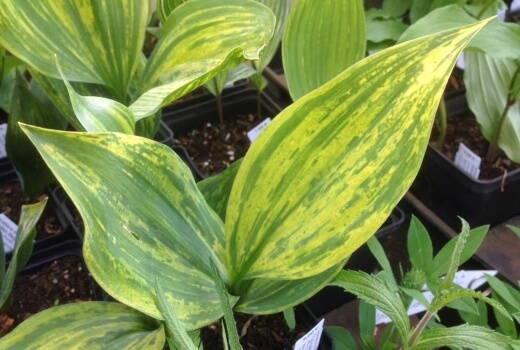
Source: shop.hostaversand.eu
Along with other cultivars like ‘Hardwick Hall’ or ‘Marcel’, this plant produces more variegation in its foliage and flowers. It is noted for its lime-green foliage that is more blotchy in its texture.
Also produces small cream flowers with a sweet scent.
Convallaria majalis ‘Berlin Giant’
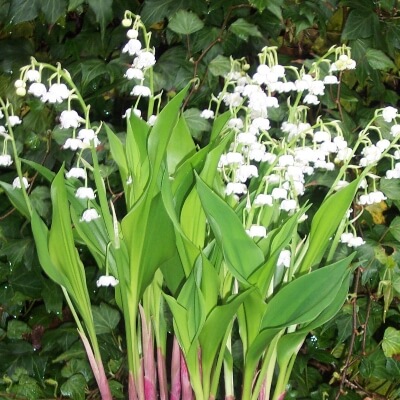
Source: etsy.com
This cultivar is large and often produces more leaves and more white flowers. Each stem can grow up to 30 giant bulbs of flower heads with bright white delicate petals.
This variety can grow 30 to 40 centimetres depending on the growing conditions.
Convallaria majalis ‘Flore Pleno’

Source: oldherbaceous.com
This special cultivar produces long-lasting double flowers with a fragrant aroma. The foliage grows in a very compact and upright habit, making this variety very ornamental with its neat and attractive form.
Rosy Lily of the Valley (Convallaria majalis ‘Rosea’)
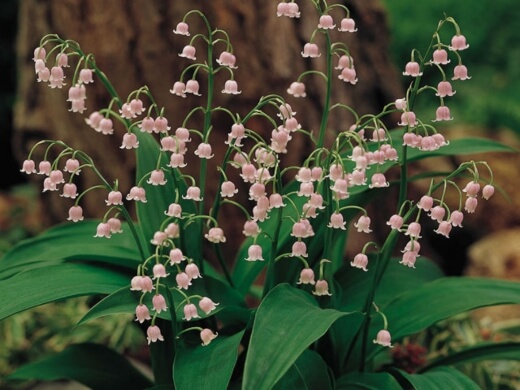
Source: worldoffloweringplants.com
As its name suggests, this cultivar features pink flowers amidst smooth and glossy upright foliage. Commonly known as the Rosy Lily of the Valley, this variety can grow up to 20cm tall and features elliptic, basal leaves and fragrant small bell-shaped mauve to pink flowers borne on delicately arching stems. All this atop smooth and luscious foliage.
Growing Lily of the Valley in Australia
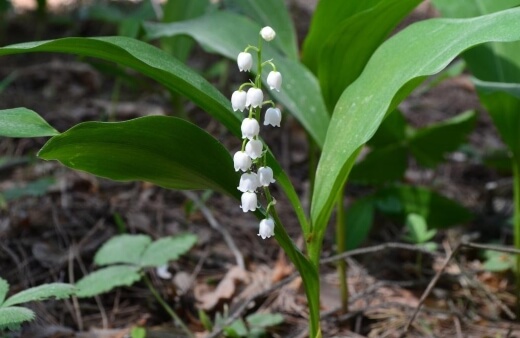
Best Conditions for Planting Lily of the Valley
It is best to plant in late summer to winter as this plant prefers cooler conditions. This is usually between May and June in Australia when the plant enters dormancy.
It’s also good to note that it does not like acidic soils or warm and humid conditions. It performs best in wintery temperatures. Here are some of the other ideal planting and growing conditions for lily of the valley.
Lighting Needs
As mentioned, these plants thrive in more shaded positions in the garden. Whether near a fence or wall or underneath larger canopying trees, these plants prefer partially shaded to fully shady conditions.
Full sun is possible but only in cooler climates. In warmer regions, the shade will be essential for proper growth and bigger blooms.
Best Soil Types
Your May bell will grow best in silty or sandy soil types that are loose with a slightly alkaline pH level. Enrich your soil before the growing season with organic compost, blood and bone or old leaf materials for prolific blooms later in spring to summer.
Quick Planting Tips
- Plant 7 to 10 centimetres apart for mass plantings with the rhizomes planted at least 3cm below the surface of the soil. This will ensure each plant has adequate space to grow.
- For containers, always use ones that have good drainage and make sure they are deep enough. Fill with a high-quality potting mix. (See this decorative outdoor garden box as reference).
- For garden beds, mix some organic compost and other organic materials into the existing soil before planting. Add a fresh top layer of compost with leaf mulch and feed with some fertiliser each year once the foliage has died back in winter. You can also use aged cow manure or a little blood and bone.
How to Propagate Lily of the Valley

Growing May Bells from Seed
- Collect your seeds wearing gloves once the red berries have ripened and turned brownish and shrivelled. This is usually after flowering when the seedpods have formed.
- Soak the seeds in lightly warm water overnight to cause them to swell and allow for quicker germination.
- Prepare small containers or seedling trays filled with quality seedling soil, compost and a layer of leaf litter for covering after sowing. This will ensure good drainage.
- Sow the seeds about 5 to 6 millimetres deep and lightly cover with your leaf litter.
- Keep the soil mix moist and water as needed.
- Place in a warm and humid location away from any harsh, direct light.
- Growing these plants from seeds can take several years before flowering begins so you will need to be patient and tend to your plant as it grows and establishes itself.
Propagating Lily of the Valley Using Division
- Divide the rhizomes or bulbs of a healthy, disease-free plant after the flowering season when the plant has died right back and entered dormancy.
- The weather should also have cooled when you carry out the division.
- Using a sharp shovel or spade, gently lift the plant from its current location, being careful to disturb the root stems as little as possible. See our compilation of the best spades and shovels here.
- Always remember to wear your gardening gloves when dealing with these plants.
- Gently locate a few clumps of the plant you can divide using your tool of choice. Each divided clump should have a healthy amount of root stems, some foliage and flower stems.
- Plant each newly divided plant into a prepared bed or container filled with well-draining quality soil.
- Water lightly after planting and keep moist.
- Place in a sheltered location in your garden that gets some sun and shade each day.
- Once you see signs of new growth, you can add some organic compost and some leaf mulch to boost your plant's nutrient intake.
How to Care for Lily of the Valley
Once established, this plant will grow best when left undisturbed. But while in its developing stages for the first year to two years, some extra care will go a long way to ensuring your plant thrives and flowers best.
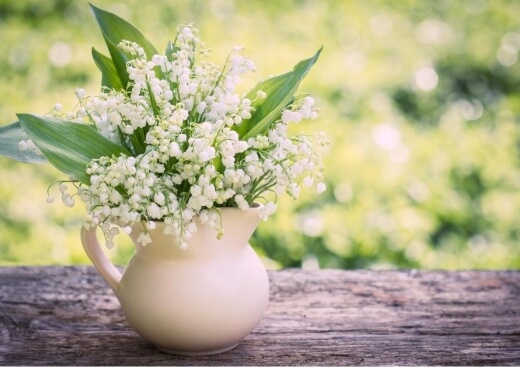
Watering Requirements
You will need to keep your plant moist, especially in the warmer months when rainfall is not sufficient. Usually, you will need to water about once per week. Don’t let your plant dry out in summer.
Add about 3cm of water around the plant to a depth of roughly 3 to 5 centimetres when the soil gets dry.
Pruning Lily of the Valley
Once your plant begins to enter dormancy during late summer to autumn and all the foliage dies back, you will need to prune back old and damaged stems or leaves. This will aid in its regrowth.
Ideal Fertilisers to Use
Always only use a light application of a pelletised fertiliser as these plants don’t respond well when fed with any nitrogen-based fertilisers. Fertilise only when needed to encourage growth or flowering.
For more in-depth information on the best fertiliser for you, be sure to check out our Yates fertiliser buying guide.
Possible Necessary Division
Plants that grow for a long time may start to show larger clump sizes emerging from the ground that will need to be divided to maintain an attractive appearance.
Even if you’re not looking to propagate, your plant may be better off if divided when it has grown to its full capacity. Remember to only separate and divide your plant in winter when it is dormant.
Lily of the Valley Frequently Asked Questions

What is special about lily of the valley?
These plants can live for decades in cool climates, elevating gardens with their beautiful sweetly-scented flowers each spring. They hold some major historical and cultural significance around the world and they make for excellent cut flowers in floral and bridal arrangements.
Is lily of the valley invasive?
Only the United States has officially listed this plant as an invasive species.
Why did my lily of the valley not bloom?
This usually occurs if the plant gets too dry, especially in the warmer months. It is normal for them to lose their blooms in fall and winter being perennial bloomers.
Interested in growing other ornamental lilies in your garden? Be sure to check out a few of our other helpful guides below:

Elevate your Garden with the Lush and Lovely Lily of the Valley
Perfect for shady gardens and those who live in cooler climates, lily of the valley will offer all the benefits of a flowering plant, easily elevating any garden setting with its fragrant flowers atop arching stems and its luscious vibrant foliage.
Whether planted to fill beds or used as a spreader to texturize the ground around other plants or larger trees in your landscape, this plant is an easy choice for cooler outdoor spaces.
Though lily of the valley does require some know-how to establish, with the tools you have now, you should have a happy and thriving flowering plant in only a few short years.
Published on December 14, 2023 by Maisie Blevins
Last Updated on February 25, 2024





My lily of the valley has been in the same pot and same soil for over a decade.
I have noticed it’s flowers thinning in past seasons.
Should I divide and put in fresh soil?
It loves it s southerly shady position here in Canberra
Hi there Rhonda,
Thanks for your question.
It sounds like you have established a lovely thriving lily of the valley.
To answer your question, yes. I believe dividing your plant and potting it into fresh soil is a fantastic idea to help boost the flowering moving forward.
These plants almost need to be divided and repotted every 5 to 8 years, especially if grown in the same pot and soil for long periods. I think your lily of the valley has outgrown its current container, hence the decrease in growth and blooms.
I would recommend dividing your plant now during its dormancy before the active season begins. Depending on the size of your plant, divide it into 2 or 3 clumps, each with its own roots, stems and foliage.
Repot into a similarly sized or slightly larger container to encourage new growth. Some fresh soil and organic compost will always go a long way in helping divided clumps establish themselves in their new homes.
Once the active season starts now in spring, feed your divided plants with a slow-release pelletised fertiliser that’s not high in nitrogen and they should begin growing and blooming again in the next few seasons.
You mentioned you already have the perfect position for your plants, so keep the newly divided plants in the same spot if possible as you know they will enjoy it there.
Have fun with your division and repotting. We hope this helped and we look forward to hearing stories of your prolifically flowering lily of the valleys soon.
Gary Clarke